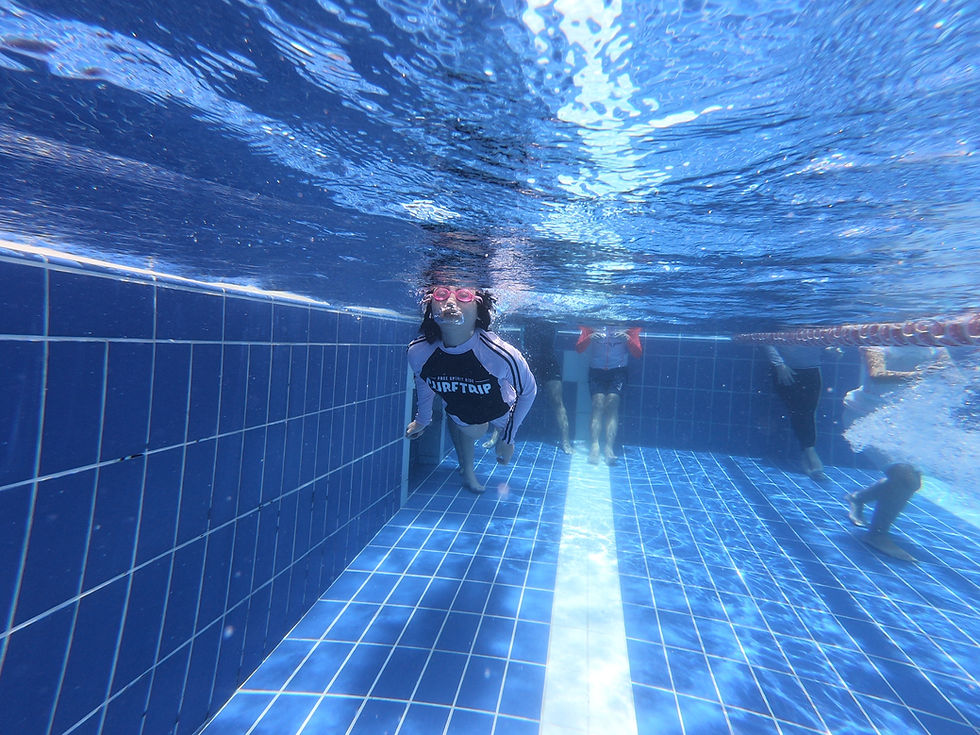How Swimming Can Improve Developmental Skills in Young Children
- SG Sink Or Swim

- Oct 5
- 4 min read

More Than Splashing — A Powerful Catalyst for Physical, Cognitive, and Social Growth
When a toddler kicks in the water, reaches for a floating toy, or giggles during a gentle back float, they’re not just having fun — they’re building the neural pathways, motor skills, and emotional resilience that form the foundation of lifelong development.
Swimming is one of the most holistic activities for young children (ages 6 months to 6 years), engaging the whole child — body, brain, and heart — in ways few other activities can. Backed by research in neuroscience, occupational therapy, and early childhood education, structured water play and swim lessons offer profound benefits that extend far beyond the pool.
In this article, we’ll explore how swimming accelerates key developmental domains — and why early aquatic experiences are a gift that keeps on giving.
🧠 1. Cognitive Development: Building Brain Power Through Play
Water is a dynamic sensory environment that stimulates neural growth and executive function.
✅ Key Benefits:
Enhanced bilateral coordination: Crossing the midline (e.g., reaching across the body for a toy) strengthens communication between brain hemispheres.
Improved spatial awareness: Navigating 3D space underwater builds mental mapping skills.
Memory and sequencing: Learning multi-step skills (“Reach, kick, blow bubbles”) strengthens working memory.
Language development: Songs, counting, and verbal cues (“1, 2, 3 — splash!”) expand vocabulary and auditory processing.
📚 Research Insight: A 2021 study in Early Human Development found that children who participated in regular swim lessons before age 5 scored significantly higher on visual-motor integration and oral expression tests than non-swimmers.
💪 2. Physical Development: Strength, Coordination, and Body Awareness
Swimming is a full-body, low-impact workout that builds foundational movement skills without joint stress.
✅ Key Benefits:
Gross motor skills: Kicking, gliding, and rolling develop core strength, balance, and coordination.
Fine motor control: Grasping toys, pouring cups, and finger movements in water refine dexterity.
Proprioception: Water resistance provides deep pressure input, helping children understand where their body is in space.
Cardiovascular health: Gentle aerobic activity supports heart and lung development.
🌊 Why water? Buoyancy reduces gravity’s pull, allowing children with low muscle tone (e.g., Down syndrome) or motor delays to move more freely and confidently.
🗣️ 3. Speech and Language Growth: Breathing, Rhythm, and Communication
The breath control required in swimming directly supports speech development.
✅ Key Benefits:
Diaphragmatic breathing: Blowing bubbles teaches controlled exhalation — the same skill used in speech production.
Oral motor strength: Blowing, humming, and vocalizing underwater strengthen lips, tongue, and jaw muscles.
Turn-taking and listening: Group classes teach “my turn, your turn” and following verbal instructions.
Nonverbal communication: Eye contact, gestures, and facial expressions flourish in the intimate, face-to-face setting of parent-child swim.
💬 Therapist Tip: Many speech-language pathologists recommend swim lessons as a complementary activity for children with speech delays.
❤️ 4. Social-Emotional Development: Confidence, Trust, and Regulation
The pool is a unique space for building emotional intelligence and resilience.
✅ Key Benefits:
Attachment and bonding: Skin-to-skin contact, eye contact, and shared joy strengthen parent-child connection.
Emotional regulation: The rhythmic, predictable nature of water movement has a calming, organizing effect on the nervous system — especially for children with sensory processing challenges.
Confidence and risk-taking: Mastering small challenges (“I floated by myself!”) builds self-efficacy.
Social skills: Group classes teach sharing, waiting, and peer interaction in a structured, supportive setting.
🌈 For children with autism: The deep pressure of water provides calming sensory input, while the visual clarity of underwater play can reduce anxiety and improve focus.
🧩 5. Sensory Integration: Organizing the Senses for Learning
Swimming is a natural sensory integration activity, engaging multiple systems simultaneously:
Vestibular (balance): Rolling, floating, and changing positions stimulate the inner ear.
Tactile (touch): Water temperature, texture, and flow provide rich tactile input.
Proprioceptive (body awareness): Resistance builds body schema.
Auditory: Muffled underwater sounds and clear surface cues enhance auditory discrimination.
🧠 Occupational therapists often use aquatic therapy to help children with sensory processing disorder develop better modulation and attention.
📅 Age-Appropriate Swim Activities & Their Developmental Payoffs
6–18 mos | Supported back floats, bubble blowing | Trust, breath control, parent bonding |
18–36 mos | Kicking with noodle, toy retrieval | Gross motor, problem-solving, confidence |
3–4 yrs | Streamline glides, basic strokes | Bilateral coordination, sequencing |
4–6 yrs | Stroke refinement, games | Executive function, social cooperation |
🧑🏫 Tips for Parents and Caregivers
✅ Focus on play, not performance — joy builds neural pathways faster than pressure.
✅ Narrate what you’re doing: “We’re blowing bubbles! Big breath in, slow blow out.”
✅ Celebrate effort, not perfection: “You tried — that’s brave!”
✅ Be consistent: Weekly lessons yield compounding benefits over time.
✅ Choose child-centered programs: Look for warm water, small ratios, and play-based curricula.
💙 Remember: The goal isn’t “waterproofing” — it’s nurturing a lifelong love of movement and water.
Final Thoughts
Swimming isn’t just a life-saving skill — it’s a developmental superpower. In the water, young children don’t just learn to float or kick. They learn to trust, to try, to breathe, to connect, and to believe in themselves.
Every splash is a neuron firing.Every bubble is a breath of confidence.Every glide is a step toward a stronger, smarter, more resilient child.
So hold their hand. Sing their favorite song. Watch them grow — stroke by stroke, bubble by bubble, in the most nurturing classroom of all: the water.
Float. Kick. Reach. Grow.
Because in the pool, every child doesn’t just swim — they thrive. 💙👶🌊





Comments